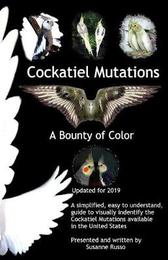
|
Cockatiel Mutations: A Bounty of Color
Paperback / softback
Main Details
| Title |
Cockatiel Mutations: A Bounty of Color
|
| Authors and Contributors |
By (author) Susanne Russo
|
| Physical Properties |
| Format:Paperback / softback | | Pages:290 | | Dimensions(mm): Height 215,Width 139 |
|
| Category/Genre | Birds, including cage birds, as pets |
|---|
| ISBN/Barcode |
9781543971859
|
| Classifications | Dewey:636.68656 |
|---|
| Audience | |
|---|
|
Publishing Details |
| Publisher |
BookBaby
|
| Imprint |
BookBaby
|
| Publication Date |
17 June 2019 |
| Publication Country |
United States
|
Description
It all started with the Normal (wild type) Cockatiel. At the time of this writing, we currently have fourteen (14) known mutations in the U.S. Of these mutations, six (6) were established in the U.S. All Cockatiels, excluding the Normal Grey are mutations. A mutation is defined as a spontaneous change in the genetic code. These changes have resulted in the color variations we now have today. Kerr identified Cockatiels (Nymphicus Hollandicus) in 1792 in their native country, Australia. The Cockatiels made their way as captive birds to Europe in the early 1800's. The first captive breeding of Cockatiels was in France in the 1850's. From there Cockatiels spread worldwide. It took about 100 years for the first mutation to evolve from the Normal, which was the Pied, in 1949. This eBook is fully detailed with illustrations showing the beauty of each of the Cockatiel Mutations found in the United States of America.
Author Biography
My journey into Cockatiels began with Boogs and Sweet Pea, shown above. I am going down memory lane now to way back in the fall of 1993. This was before there was the abundance of information available today about genetics and mutations. Breeding was a very rewarding experience and each day I looked forward to being around my birds and working with them. Over the years my birds have taught me a lot. In my early years, I read information on mutations, but when working with the mutations I learned that not all the available information was accurate or complete. Most available info was text with no photos or illustrations. Even though there was descriptive text, it left a lot to the imagination, thus leading to wrong identification of birds and/or sexes.In the late 1990's I started to digitally document everything regarding the mutations, and other issues such as health. I started compiling them into collages that contained helpful information written on the collage. I found it more understandable when a person is shown something. The collage will show the birds in more natural poses and several different angles and positions, rather than stagnant glamour or studio shots that have no dimension, or as just a singular representation of the mutation. Thus my birds taught me a lot and it is my time to Pay It forward with all they have taught me.Ok, now about me...hmmm...not much to say except I have always enjoyed teaching and helping others.
|